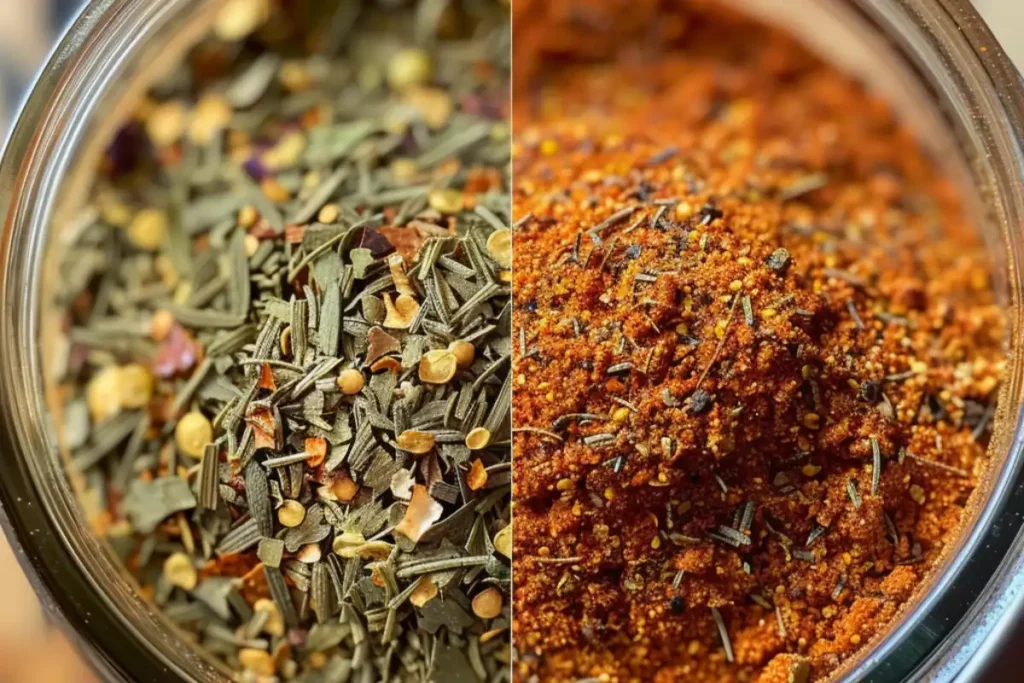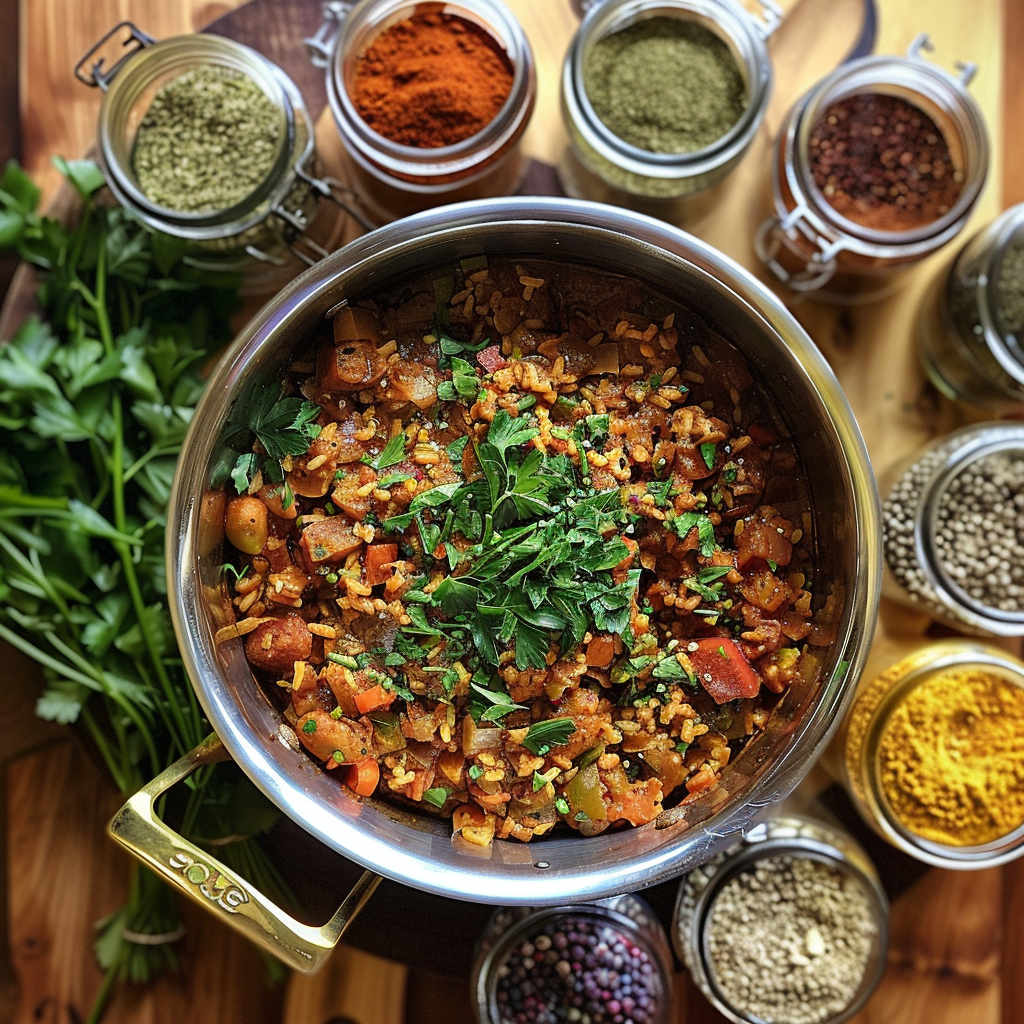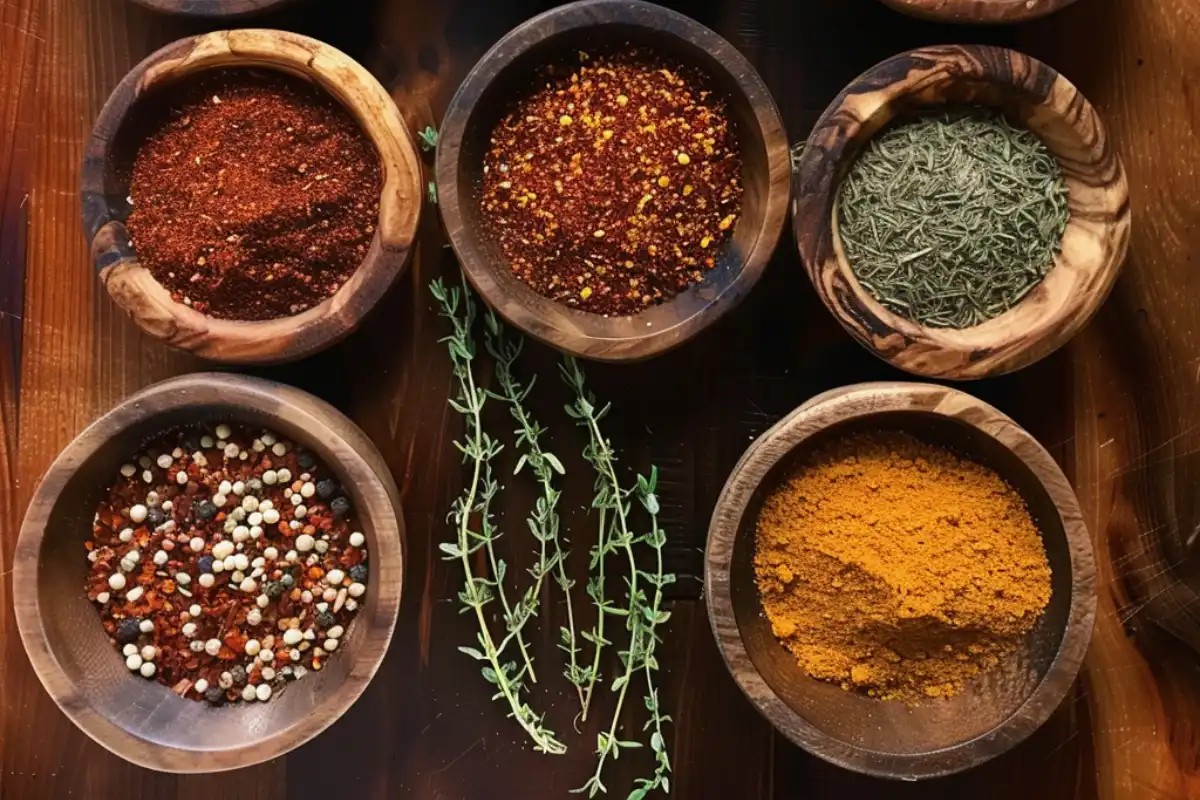Cajun seasoning is a staple in Southern cuisine, especially in iconic dishes like Jambalaya. This unique blend of spices brings the perfect balance of heat, smokiness, and earthiness to the dish. However, if you find yourself without Cajun seasoning, it doesn’t mean your Jambalaya has to lack flavor. Whether you’re out of the seasoning or looking for a milder option, there are several Cajun seasoning substitutes for Jambalaya that can still deliver the rich, complex taste you crave. From Creole seasoning to Old Bay, and even simple spice mixes you can make at home, these alternatives offer easy ways to maintain the authentic flavors of Jambalaya while giving you flexibility in the kitchen. In this guide, we’ll explore the best substitutes and how to use them in your recipes.
The Role of Cajun Seasoning in Jambalaya
The key to a flavorful Jambalaya is in its seasoning. Cajun seasoning typically includes a blend of paprika, cayenne pepper, garlic powder, onion powder, black pepper, and occasionally herbs like thyme and oregano. The key to this blend is the balance between heat from the cayenne and the smoky, earthy tones from paprika and other herbs. Jambalaya, as a dish that thrives on bold flavors, heavily relies on this seasoning to deliver its characteristic depth and spice.
Because Jambalaya is a dish rooted in Louisiana’s culinary traditions, using Cajun seasoning is key to achieving its authentic taste. But if you’re in a pinch or want to try something new, understanding the spice’s core elements will help you recreate its essence with Cajun seasoning substitutes for Jambalaya, allowing you to maintain the dish’s bold flavors even without the original blend.For more on how to season Jambalaya properly, check out this guide on Jambalaya seasoning.
How to Substitute Cajun Seasoning
Whether you’re out of Cajun seasoning or seeking to reduce heat in your dish, several alternatives can provide a similar flavor profile while keeping the essence of Jambalaya intact.
1. Creole Seasoning
One of the closest alternatives to Cajun seasoning is Creole seasoning. Both blends come from Louisiana’s culinary traditions, but Creole seasoning tends to have a more herbaceous flavor profile. It often contains oregano, thyme, and basil, along with paprika and cayenne pepper.
While Cajun seasoning focuses more on the heat and earthy tones, Creole seasoning provides a slightly more refined balance of herbs and spices. This makes it perfect for dishes that are rich in tomatoes, like tomato-based Jambalaya.
Substitution Tip: Use a 1:1 ratio when replacing Cajun seasoning with Creole seasoning. If you prefer more heat, you can always add a bit more cayenne pepper or crushed red pepper flakes.
Creole seasoning tends to have a more herbaceous flavor profile, perfect for tomato-based dishes like Jambalaya. You can explore more about the differences between Cajun and Creole cuisine to understand how these seasonings vary.

For an in-depth look at how the seasoning in Jambalaya affects its taste, refer to what makes Jambalaya taste like Jambalaya.
2. Old Bay Seasoning
Old Bay seasoning is another excellent substitute, particularly if you’re making a seafood-based Jambalaya. Known for its use in seafood dishes, Old Bay has a similar flavor profile with ingredients like celery salt, paprika, and black pepper. It provides a more subtle heat compared to Cajun seasoning but still delivers a flavorful punch.
The addition of celery salt in Old Bay adds a layer of complexity that works well with seafood Jambalaya, and though it doesn’t have the fiery kick of Cajun seasoning, it complements the dish without overpowering the other ingredients.
Substitution Tip: Use Old Bay seasoning in the same amount as Cajun seasoning. If you miss the heat, you can enhance the spice by adding some cayenne pepper or chili flakes.
If you’re interested in making your own version of Old Bay, check out this guide on how to make Old Bay seasoning at home
3. Paprika and Cayenne Pepper Mix
If you don’t have a pre-made seasoning blend available, you can create a simple mix of paprika and cayenne pepper. These two spices are key components of Cajun seasoning and can replicate its smoky, spicy flavor.
The combination of smoked paprika and cayenne provides the foundation of the Cajun flavor, and if you enjoy a bit of experimentation, adding some black pepper and garlic powder to the mix can elevate the dish even further. You can adjust the amount of cayenne depending on your desired heat level.
Substitution Tip: Mix equal parts smoked paprika and cayenne pepper. Adjust the ratio depending on how spicy you want the dish.
4. Adobo Seasoning
Adobo seasoning is another great alternative if you’re open to a slightly different flavor profile. Common in Latin American and Filipino cuisines, Adobo seasoning contains a combination of garlic powder, onion powder, black pepper, oregano, and paprika. While Adobo seasoning isn’t as spicy as Cajun seasoning, you can enhance the heat by adding more cayenne pepper.
The smoky and savory qualities of Adobo make it a perfect match for Jambalaya, and though the flavor will be slightly different, it will still blend well with the other ingredients in the dish. For more information on the history and uses of Adobo seasoning, this guide provides valuable insights.
Substitution Tip: Use Adobo seasoning in the same quantity as Cajun seasoning, and add extra cayenne to taste.
5. Blackened Seasoning
For those who enjoy a more intense, charred flavor, Blackened seasoning is a great substitute. Blackened seasoning shares several ingredients with Cajun seasoning, such as paprika, cayenne pepper, and garlic powder. Originally designed for blackened fish or chicken, this seasoning brings a bold, spicy flavor to your Jambalaya.
The blackened method originated in Cajun cuisine, where it was used to coat fish or meat before cooking at high temperatures, resulting in a crispy, flavorful crust. While not traditionally used in Jambalaya, Blackened seasoning can still provide a wonderful depth of flavor to the dish.
Substitution Tip: Replace Cajun seasoning with Blackened seasoning at a 1:1 ratio.
6. Chili Powder and Garlic Powder Mix
If you’re looking for a quick and easy substitution, mixing chili powder with garlic powder can offer a similar profile to Cajun seasoning. Though it lacks the depth and complexity of traditional Cajun blends, it still brings the heat and earthiness that Jambalaya needs.
Chili powder typically contains a blend of cumin, paprika, and chili peppers, which provides both smokiness and spice. When combined with garlic powder, it can mimic the basic structure of Cajun seasoning.
Substitution Tip: Mix 1 teaspoon of chili powder with 1/2 teaspoon of garlic powder and paprika. This blend will offer a similar flavor but can be adjusted based on your spice tolerance.
Non-Spice Alternatives for a Unique Twist
If you’re looking to experiment with unique flavors or prefer a milder seasoning, there are non-spice alternatives that can add interesting dimensions to your Jambalaya. While these options deviate from the classic Cajun flavor profile, they still bring complexity and depth to the dish. By using Cajun seasoning substitutes for Jambalaya, such as fresh herbs or different spice blends, you can create a flavorful twist on the traditional recipe while maintaining the essence of the dish.
7. Fresh Herbs and Spices
If you prefer using fresh ingredients, you can try combining fresh garlic, parsley, and bay leaves. These fresh herbs provide a brighter, more aromatic twist on Jambalaya, giving the dish a refreshing quality that complements the richness of the meat and vegetables.
The use of fresh herbs adds an element of vibrancy that dried seasonings often lack. Garlic and parsley add sharpness, while bay leaves bring an earthy undertone. This combination works particularly well if you’re using chicken or seafood in your Jambalaya.
Substitution Tip: For every tablespoon of Cajun seasoning, use 1 minced garlic clove, 1 tablespoon of chopped parsley, and 1/4 of a fresh chili pepper for heat.
8. Poultry Seasoning or Gumbo File Powder
For a more savory, herb-forward alternative, consider using poultry seasoning or Gumbo File powder. Poultry seasoning often includes herbs like sage, thyme, and rosemary, which add a different flavor profile but still complement Jambalaya. Meanwhile, Gumbo File powder—made from ground sassafras leaves—adds a slightly sweet and earthy flavor that works well in Louisiana-style dishes.
Though these alternatives won’t bring the heat of Cajun seasoning, they provide an interesting twist on the traditional Jambalaya flavor.
Substitution Tip: Use 1 teaspoon of either poultry seasoning or Gumbo File powder in place of each tablespoon of Cajun seasoning.
Experimenting with International Flavors
If you’re feeling adventurous, you can try incorporating international spices to create a global spin on your Jambalaya. These spices won’t replicate Cajun seasoning substitutes for Jambalaya exactly, but they offer a unique way to reimagine the dish. Experimenting with flavors like garam masala or za’atar can introduce new, exciting dimensions while still complementing the traditional elements of Jambalaya.
Garam Masala
A staple of Indian cuisine, garam masala is a blend of warming spices like coriander, cumin, cardamom, and cloves. While it doesn’t provide the heat of Cajun seasoning, it delivers a depth of flavor that can be quite satisfying in a savory dish like Jambalaya.
Substitution Tip: Use garam masala sparingly, starting with 1/2 teaspoon and adjusting to taste. To add heat, combine it with chili powder or cayenne.
Za’atar
A blend of sumac, sesame seeds, and herbs, za’atar is common in Middle Eastern cuisine and offers a tangy, herbal flavor. This blend pairs well with grains and meats, making it an interesting choice for Jambalaya if you want to experiment with new flavors.

Substitution Tip: Start with 1 teaspoon of za’atar and adjust as needed. This blend works particularly well in vegetarian Jambalaya.
Homemade Cajun Seasoning Recipe
If you enjoy making your own spice blends, creating a homemade version of Cajun seasoning is easy and allows you to control the spice level. Here’s a basic recipe for homemade Cajun seasoning:
Ingredients:
- 1 tablespoon paprika
- 1 tablespoon smoked paprika
- 1/2 tablespoon cayenne pepper
- 1 tablespoon garlic powder
- 1 tablespoon onion powder
- 1 teaspoon dried thyme
- 1 teaspoon dried oregano
Instructions:
- Combine all ingredients in a small bowl and mix well.
- Store in an airtight container and use as needed.
This homemade seasoning can be used in any recipe that calls for Cajun seasoning, including Jambalaya. If you’re interested in trying new dishes with bold flavors, check out this Hawaiian garlic shrimp recipe, which is a delicious option for seafood lovers.
Frequently Asked Questions (FAQs)
Can I use Creole seasoning instead of Cajun seasoning?
- Yes, Creole seasoning is an excellent alternative to Cajun seasoning. While Creole tends to be more herbaceous, it still provides the necessary flavor profile for Jambalaya. To match the heat of Cajun seasoning, consider adding extra cayenne pepper.
What can I add to Old Bay seasoning to make it taste more like Cajun seasoning?
- You can add cayenne pepper and garlic powder to Old Bay to create a flavor more similar to Cajun seasoning. This will enhance the heat and earthiness, making it perfect for Jambalaya.
Is there a non-spicy alternative to Cajun seasoning?
- If you prefer a milder flavor, you can use all-purpose seasoning or poultry seasoning instead of Cajun seasoning. These blends won’t add much heat but will still provide savory, herbal notes that work well in Jambalaya.
Can I make my own Cajun seasoning at home?
- Absolutely! Making your own Cajun seasoning is easy and allows you to customize the spice level. Start with a base of paprika, cayenne, and garlic powder, and adjust the herbs and spices to your taste.
Conclusion
In conclusion, while Cajun seasoning is a key ingredient in traditional Jambalaya, it’s not irreplaceable. With the right Cajun seasoning substitutes for Jambalaya, such as Creole seasoning, Old Bay, or even a homemade spice blend, you can still achieve a flavorful, authentic dish. Don’t be afraid to experiment with different combinations to find the perfect substitute that fits your taste, ensuring your Jambalaya remains as bold and delicious as ever. For more on seasoning Jambalaya, visit this helpful guide on Jambalaya seasoning.
If you’re looking to expand your culinary horizons, be sure to try this Hawaiian garlic shrimp recipe, which pairs well with a variety of seasonings.

